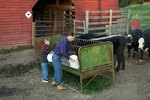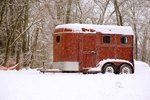Things You'll Need
tools including hammer, nails, screwdrivers, measuring tape
gate
wooden boards
You can convert a garage into a stable to house horses or other livestock. Some garages will take significantly more effort to modify than others, depending on the overall structure of the garage and what it is built out of. A wooden or detached metal garage will require less work to modify than a concrete garage will.
Measure your garage. Typical barn stalls are 12 by 12 feet or larger, so you will need to make sure your garage is large enough to accommodate the animals you want to house in it. A single-car garage will probably only be large enough to house one horse or cow, while a two-car garage may house two or three animals, depending on the dimensions.
Ensure adequate ventilation. Animals need windows and a good source of airflow; cars do not. Many garages have very limited airflow. You need to add windows to your garage if you plan on housing animals in it. If your garage already has windows, you are in luck. If your garage does not, you need to contact a professional building contractor to inquire about adding windows to the structure. It is important to have this done by a professional because improper structure modifications with uneven edges or those that undermine the stability of the garage can be dangerous for your animals.
Evaluate lighting and add light fixtures as needed. Cars can be kept in the dark, but living creatures need light to see where they are going and what they are doing. If you garage is dimly lit or does not have electrical lighting, you need to have an electrician install light fixtures in your garage. Once again, you do not want to do this on your own due to the risk of creating hazardous living conditions for your animals.
While your electrician is on the premises, you may also want to have him install additional electric sockets in the garage so you can plug in various animal-related equipment, such as fans to provide additional ventilation.
Make sure you have a way to get running water in your garage. You can either run a hose from an existing faucet or have a plumber install new equipment.
Construct stalls. Use the support beams in your garage as a basis for constructing stalls to hold your animals. Depending on the number of animals you plan on housing and their general temperaments, you may need to build partial or full walls to divide stalls. You can build simple walls by fixing either 2-by-4 or 2-by-6 wooden boards onto your existing support structures. You need at least three horizontal boards dividing the stalls. Your wall should be a minimum of four feet tall. If your animals are aggressive, avoid leaving any gaps between boards, and make your wall six to eight feet tall.
Add gates. You need to put gates across the fronts of the stalls to let animals in and out. You will also want to put one large gate across the front of your barn to keep animals in while allowing for good airflow during warm months. If you will only have one stall, this large gate across the front is the only gate you will need.
You can attach gates by screwing the gate hinges to your existing walls. You can purchase premade livestock gates or build them by assembling 2-by-4 boards into a solid square or rectangle the size of the opening and attaching hinges to one side and an eye bolt with a chain and hook to the other.
Install livestock supplies.
Buy a large plastic storage bin for feed that your animals can not get into. If you are planning on keeping horses, mules, donkeys or cows in your stable and have a concrete floor, purchase rubber stall mats and place them over the concrete, completely covering the floors. Concrete floors can rub and damage animals' skin and joints when they lie down on it, so it is important to have four to six inches of padding between your animal and the concrete floor. Once the stall mats have been installed, cover the stall floors with shavings to add additional padding.
Bring in feed and water buckets for your animals. You can use freestanding buckets, or you can use eye-bolts and hooks to attach them to your walls.
Once you have finished bringing in your supplies, your stable will be ready for animal occupancy.
Warnings
Improperly done renovations can be dangerous for you and your animals. Construction renovations should be performed by professionals.
References
Photo Credits
-
red garage image by Christine F Saulnier from Fotolia.com
Writer Bio
Jen Davis has been writing since 2004. She has served as a newspaper reporter and her freelance articles have appeared in magazines such as "Horses Incorporated," "The Paisley Pony" and "Alabama Living." Davis earned her Bachelor of Arts in communication with a concentration in journalism from Berry College in Rome, Ga.



